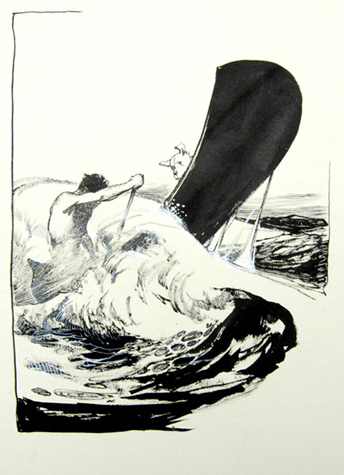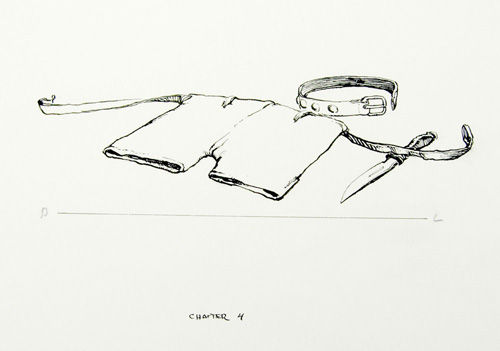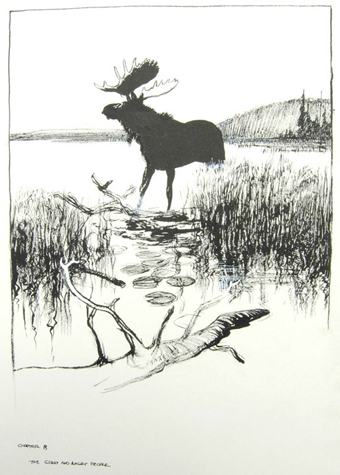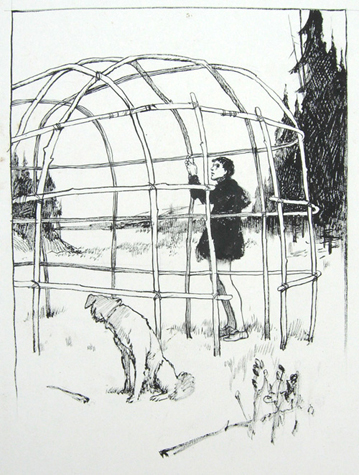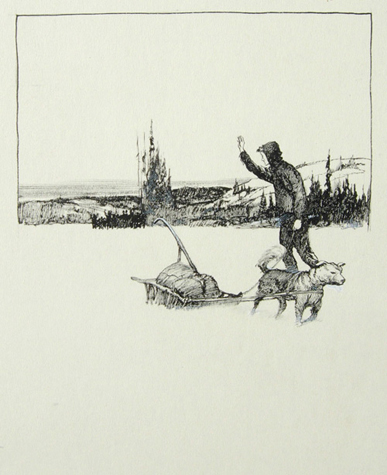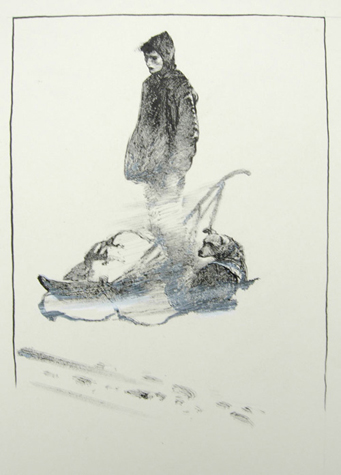|
ORIGINAL KREIGH COLLINS ILLUSTRATIONS FOR THE LONE WOODSMAN Kreigh T. (Taylor) Collins was born in Davenport, Iowa, on January 1, 1908, to Stephen W. and Nora C. Collins. He attended high school at Cincinnati (Ohio) High, where he majored in art, but dropped out at 16 to pursue art as a career. He studied art in Cleveland (1924-1925), and in 1925 opened his own studio. It was during this period that he met Theresa VanderLaan, whom he married in 1929 after a year spent studying in Paris (with visits to North Africa). She became the model for characters in “Up Anchor” and “Kevin the Bold,” as well as model for many of his sketches and paintings. They moved to Chicago in 1929, where he made illustrations for an advertising agency. In the fall of 1930 the Collins family moved to Grand Rapids, Michigan, where he again took up advertising illustration even though he disliked such work. Then, in 1931, he and Theresa returned to Paris where he studied and first began to concentrate on landscape painting. They returned to the United States in the midst of the Depression, but Collins did well by selling the landscapes he painted while living in the small village of Leland, Michigan. He also contracted with a newspaper syndicate to illustrate the “Do You Know” series by Willis Atwell for the Michigan Centennial. During the next two years, he painted portraits in Ohio, eight murals in Dallas, Texas, and landscapes in Taos, New Mexico. All this work caught up with him, and by 1937 he could no longer use his right arm to paint. He discovered, however, that he could make line drawings by resting his elbow on the arm rest of a chair with his forearm on a drawing board. The Methodist Publishing House, which had until then bought only a few of his travel sketches, started sending him large quantities of work. He also illustrated the Informative Classroom “Teaching Pictures.” In 1941 he found he could do a small amount of painting again without pain, and among other projects painted an official portrait of a Michigan Supreme Court Justice. In 1948 Collins syndicated a comic strip titled “Mitzi McCoy.” The strip was a great success, and in 1950 “Kevin the Bold” was launched. “Kevin” was equally successful, and had a long run. Then in 1968 Collins started a new type of comic strip, “Up Anchor”, which was a departure from either the adventure or the slapstick form, the prevalent types then in vogue. The new strip followed the daily lives of a family on a sailboat. This strip also proved to be a success, and continued until Collins’ retirement in 1973. Collins died on January 8, 1974. His wife gave many of his papers and much of his artwork to the Grand Rapids Public Library where it is still being catalogued. Collins both wrote and illustrated a number of books, which are now all but forgotten except for The Lone Woodsman, which was written by Warren Hastings Miller and first published in 1942 by John C. Winston of Philadelphia. Today the book owes its iconic status among boys’ adventure stories in no small part to Collins--his sensitive ink drawings of the strapping young man Dan and his faithful dog Pepper spark the plodding prose with drama and passion. His accomplishment is all the more amazing for happening during a period when his drawing arm was causing him pain. It is unfortunate that the reproductions of his drawings were printed on cheap paper, which made the black printer’s ink spotty, resulting in a loss of detail.
Dan Pickett is the nineteen-year-old son of an ethnologist–of course his mother is never mentioned. A “ tall, rangy youth, deeply sunburned from wearing nothing but a stout pair of bathing trunks all summer,” Dan sets out for the wilderness of Upper Ontario where he will gather information about the Cree Indians for his father. He will go alone except for his mongrel dog Pepper because his father believes “a boy companion will only hamper you.”
From the start of the journey, Pepper proves to be the wiser of the two adventurers. As soon as they leave civilization, a storm forces them to make temporary camp on the near shore of a vast and treacherous lake. After several days in his well-supplied if makeshift shelter, exasperated Dan decides to try to make it to a couple of islets six miles out into the white-capped waters, but Pepper disappears. Dan has to pretend to leave him behind and when the loyal dog comes wimpering out of the woods he is forced into the frail canoe. Of course the boat and all but a knife and a belted bathing suit are lost. Dan gets leg cramps so an exhausted Pepper has to drag him to shore.
Once Dan gets a fire started by drilling dry sticks into each other, the two weary souls dry out and start to consider their food options. They capture some frogs whose legs provide a bit of nourishment and bones to make fish hooks and from there on up the food chain to a pike. After making a bow and some arrows, they move up to hares and grouse and a yet larger bow that wounds a buck, but does not prevent an attack in which Pepper is gored by antlers and Dan is stabbed with sharp hoofs. The deer carcass lures a pack of wolves that nearly kill Pepper before they are vanquished.
While their wounds heal, Dan sets about building a bear trap and a raft, the former to have a warm robe for the coming winter; the latter to gather stores wild rice, arrow-lily tubers, and bullrushes from the marshes of a nearby pond.
After unloading their bounty at the camp site, Dan decides to take the raft out again to gather more lily roots. “Then, from far back in the hills came a cry, long-drawn and indescribably longing, ending in a sort of grunt. In a spirit of boyish mischief, Dan cupped his hands and answered the call of that bull moose.” Oh that boy! The horny moose charges the raft and destroys it, forcing foolish Dan and poor Pepper to swim for their lives once again.
While the moose was wrecking the raft a wolverine was ruining all the winter stores in the camp, but before that mess could be cleaned up a tempest sweeps away everything except the few skins and tools Dan could carry to high ground.
Dan decides to move his camp away from the dangerous lake shore to the protected pond where they had found the wild rice. Little did he know that the rice was not so wild--it had been planted by the very Cree Indians he had set out to study. They too were returning to the pond to set up their winter camp as Dan discovers when James Henry Nimigosh appears in the doorway of his newly completed wigwam. “Dan looked up to see an Indian youth standing nearby. His hand was held up in the sign of peace. He was tall and straight as a lance. His buckskin shirt was richly embroidered with porcupine-quill floral and leaf designs. Its fringes were dyed green and his shoulder and legging straps were brilliant with quill-work. ‘How!’ said the youth.” Taking the young buck’s friendliness as an opportunity to resume his ethnic research, Dan asks James Henry about watching the feasts of the rice gathering. Eager to please, James Henry says, “Sure ‘bout dat! Come; I show you my drum!” “He pulled his drum and its stick out and Dan fingered it hungrily. It was a flat, single-headed drum with a taut caribou skin stretched over it. Dan grasped the spreader-sticks in his left fist and began a lively rhythm.” After that satisfying encounter with his Cree friend, Dan returns to his camp. He decides he will make a blow gun as a way to conserve arrows. After using fire to force a grub to eat an escape by boring through the center of a sapling, he goes out to the pond to find thorns to use for dart points. He stands and admires two Indian girls passing by on the thin pond ice. His admiration is far from carnal: “The Smithsonian could well use those garments in dressing a Cree Indian group, Dan thought; but he shook his head as he heard the ice popping under the girls.” Sure enough, the girls fall through the ice and Dan and Pepper rescue them. Thus the whole Cree village is indebted to him and he will get not only the girls’ clothing but also a heap of other things including James Henry’s musical instrument for “great houses where all things that the Indians make are kept in glass cases; where all white men may come to see them and know how splendid a man is his red brother.”
Dan has been waiting for the vast treacherous lake to freeze so he can cross the water to Osnaburgh House, his original destination. To make the crossing he needs a toboggan and snowshoes. To make them and leggings for his still bare legs, he needs deer hide so he goes out hunting and, while tracking a caribou, he gets lost. James Henry Nimigosh saves Dan and Pepper by guiding them back to the pond with smoke signals.
Dan lashes together a toboggan, weaves rawhide into snowshoes, and is ready to say goodbye to the Crees. He will not be able to carry their many gifts on the small toboggan–they will be sent to the Nipigon Post in the spring and from there they will be shipped to “the Great House with the glass cases.” “Bah gosh, I lak see that house!” Nimigosh exclaims. “All us Injun t’ing?” And so a plan is made for James Henry to visit Dan in Minnesota, “You and I, we go see the Big House!” Dan takes his leave and before long he and faithful Pepper are all alone in the great frozen North. “He was alone in the world as if in the center of an arctic sea. Flat, level, white, and silent as death, the vast white horizon rim curved around him.”
“Pep howled piteously and bogged down in the snow. Dan put him on the toboggan. Snow was already falling. Gradually a white haze closed in the horizon around him. The trees on the distant shore, once distinct, disappeared.” When he discovers his own tracks, Dan realizes he has been traveling in a circle and is lost. He and Pep wait out the three-day storm buried in a pit dug out of the snow and roofed with the toboggan. When the sun finally blazes a blinding trail to the timbered shore, which Dan knows is “Hungry Land” for packs of wolves that easily chase down deer hobbled by the deep snow. “A-ooo-ooo-ooo! A deer had reached the lake bank, some distance west of Dan’s camp.” “There were rustkings now in the forest. Presently two green eyes flashed at him, reflecting the firelight. Dan could just make out the gray shape of a timber wolf looking at them. Then came more flashing eyes and more.” Dan manages to stab one wolf and it was immediately eaten by the others. He killed another and that too was devoured, but the camp fire starts sputtering out and as it dies the emboldened wolves circle ever closer and closer. “Could he and Pep survive that last dash at close quarters?” “‘Dan?’” cried a voice from the hill. “‘Dan! Oh, Dan! It’s your father calling!’ In a second more Dan was in his father’s arms. ‘Son! Let’s look at you!’ Doctor Prickett cried out delightedly.” |


